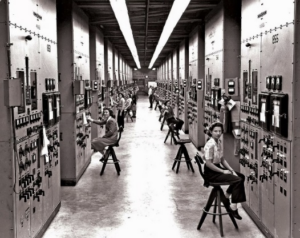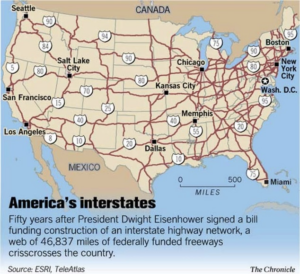
Point/Counterpoint — When it comes to Rapid Energy Transition, is spending other people’s money a moral hazard of separating actions and consequences or is it visionary leadership?
Throughout history, the ambitious plans and projects of wealthy societies’ leaders have sparked both awe and controversy. These grand endeavors, usually funded by Other People’s Money (OPM), can flow from lofty ideals or questionable motivations.
While some of these projects may be the ultimate expressions of visionary leadership, driving societal progress and innovation, others were risky and wasteful ventures detached from immediate practicalities and rational economic considerations.
This point/counterpoint article delves into the dichotomy of such monumental undertakings by examining historical and contemporary examples, from the construction of the Egyptian pyramids and the ambitious NEOM project to the transformative Manhattan Project and the far-reaching Federal Highway System.
Each example highlights the delicate balance between visionary ambition and the potential pitfalls of using OPM, inviting a closer look at the concept of Rapid Energy Transition (RET). This tension leads to the question: Is the proposed speedy transformation of how we make energy an example of the moral hazard of separating actions and consequences or a case of visionary leadership where hoped-for future benefits will dwarf upfront costs and tradeoffs?
Point
History is replete with leaders of wealthy societies pursuing grand, multi-generational, society-shaking plans using OPM based on challenged reasoning. These leaders are sometimes victims of a moral hazard resulting from the separation of actions and consequences created by using OPM. The outcomes of these grand gestures take many years to be realized and while they don’t escape the challenge of logic, they do escape the hard truth of history until long after society’s money has been spent.
Consider some of the world’s greatest projects, old and new:
Egyptian Pyramids
 The Egyptian pyramids were built by pharaohs thousands of years ago when Egypt was the richest and most powerful society in the world. These massive royal tombs were monuments to deceased rulers and were filled with artifacts, prized objects, and members of the pharaoh’s entourage. Notably, pyramid building disappeared when Egypt’s prosperity ebbed about 4,000 years ago.
The Egyptian pyramids were built by pharaohs thousands of years ago when Egypt was the richest and most powerful society in the world. These massive royal tombs were monuments to deceased rulers and were filled with artifacts, prized objects, and members of the pharaoh’s entourage. Notably, pyramid building disappeared when Egypt’s prosperity ebbed about 4,000 years ago.
NEOM
 NEOM (Wall Street Journal) is a major construction project that can best be described as a plan to construct a 26,500-square-kilometer city in the desert of the Arabian Peninsula. The most intriguing element of NEOM is a pair of multitrillion-dollar skyscrapers taller than the Empire State Building. These two buildings are designed to be over 100 miles long, 1,250 feet tall, and house nine million people.
NEOM (Wall Street Journal) is a major construction project that can best be described as a plan to construct a 26,500-square-kilometer city in the desert of the Arabian Peninsula. The most intriguing element of NEOM is a pair of multitrillion-dollar skyscrapers taller than the Empire State Building. These two buildings are designed to be over 100 miles long, 1,250 feet tall, and house nine million people.
Counterpoint
History is filled with examples of leaders of wealthy societies pursuing grand, multi-generational, society-shaking plans using OPM for the best of reasons. These leaders are sometimes visionaries able to see past society’s immediate needs and catalyze investment in a greater future. The outcomes of these grand gestures take many years to be realized, and while they don’t escape the challenges of the status quo, they do move society dramatically forward in self-realization.
Consider some of the world’s greatest projects, old and new:
Manhattan Project
 The Manhattan Project (Atom Bomb) was a research and development program undertaken during World War II in the race to produce the first nuclear weapons before Nazi Germany. It employed nearly 130,000 people at more than 30 sites and cost about 0.75% of the USA’s total expenditures on WWII. It took a lot of practical engineering guesswork and trial and error to convert brand-new, high-level physics theory into workable machinery. In only three years, the project built the first nuclear reactor, tried out multiple methods of producing uranium and plutonium, and ultimately two types of atomic bombs: Fat Man (an implosion-type weapon) and Little Boy (a nuclear fission weapon). This sci-fi fantasy project was an attempt to offset an existential threat to civilization and led to clean nuclear power. It truly reflected visionary leadership in the face of great uncertainty.
The Manhattan Project (Atom Bomb) was a research and development program undertaken during World War II in the race to produce the first nuclear weapons before Nazi Germany. It employed nearly 130,000 people at more than 30 sites and cost about 0.75% of the USA’s total expenditures on WWII. It took a lot of practical engineering guesswork and trial and error to convert brand-new, high-level physics theory into workable machinery. In only three years, the project built the first nuclear reactor, tried out multiple methods of producing uranium and plutonium, and ultimately two types of atomic bombs: Fat Man (an implosion-type weapon) and Little Boy (a nuclear fission weapon). This sci-fi fantasy project was an attempt to offset an existential threat to civilization and led to clean nuclear power. It truly reflected visionary leadership in the face of great uncertainty.
Federal Highway System
 In 1956, President Dwight D. Eisenhower signed the Federal-Aid Highway Act of 1956 (Federal Highway System), creating a 46,837-mile national highway system. National leaders embarked on this gigantic project that would impact every citizen, town, and state in the U.S., and cost an estimated $300 billion (2023 dollars) paid for by an increased federal gasoline tax. This commitment was called essential to the national interest and connected the nation enabling tremendous economic growth and a dramatically improved living standard. This endeavor also reflected true visionary leadership.
In 1956, President Dwight D. Eisenhower signed the Federal-Aid Highway Act of 1956 (Federal Highway System), creating a 46,837-mile national highway system. National leaders embarked on this gigantic project that would impact every citizen, town, and state in the U.S., and cost an estimated $300 billion (2023 dollars) paid for by an increased federal gasoline tax. This commitment was called essential to the national interest and connected the nation enabling tremendous economic growth and a dramatically improved living standard. This endeavor also reflected true visionary leadership.
Rapid Energy Transition
As global warming begat climate change, which begat RET, stable energy policy became challenging. The Green New Deal, initially mocked by many, developed into an important element of RET under which society has committed tremendous wealth to chase uncertain social and energy objectives to forestall global climate change. Does this expenditure of trillions of dollars represent a grand gesture by leaders suffering from the OPM moral hazard born of the separation of actions and consequences?
Notably, global temperatures are slowly but surely rising. It is also noteworthy, however, that even with adherence to the Paris Accords, fossil fuels will comprise 70% of the world’s primary energy sources by 2050, and consumption of such fuels will have risen by almost 30% (Institute for Energy Research).
Moral hazard or visionary leadership? The prognosis for RET is uncertain and the national energy policy is not fully grounded. In time, RET’s impact on society will become known. In the meantime, leaders in government thinking about energy and the climate, as well as all affected groups, should commit to a full understanding of all relevant facts. Every step forward will involve tradeoffs between reliability, affordability, and sustainability. We can’t afford hubris or willful ignorance on any side of this discussion.
This essay is the third of a planned series from Thomas Kalb, energy expert and Director of the Coastal Bend Midstream Program at Texas A&M University-Corpus Christi, examining issues, policies, and considerations impacting how we produce and use energy.
Let’s Clear the Air has received permission to publish this article on behalf of Thomas J. Kalb.
Share This
